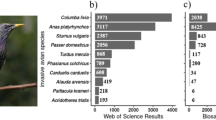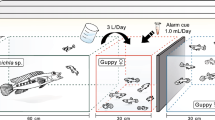Abstract
While sexual selection in mammals with female defense systems has historically received considerable attention, much less is known about the factors affecting reproductive success in mammalian species with scramble competition mating systems. Using mark–recapture techniques and DNA microsatellite loci to assign parentage, we examined the mating system and factors affecting the variation of the annual reproductive success in an introduced population of the Siberian chipmunk, Tamias sibiricus, a small, monomorphic, solitary squirrel. Our analyses showed that breeding females were spatially dispersed, setting the stage for a scramble competition mating system. Male reproductive success was positively associated with the size of the home range. The strength of sexual selection on this behavioral trait was very strong, equaling previous estimates for morphological traits in female defense mating systems. These findings suggest that a behavioral trait, space use, strongly influences the annual reproductive success in males, which is consistent with expectations in a scramble competition mating system. In both sexes, reproductive success was influenced by habitat, with twice as many juveniles produced in semi-open than in closed habitat, possibly due to differences in food availability between the two habitats.



Similar content being viewed by others
References
Andersson M (1994) Sexual selection. Princeton University Press, Princeton
Arak A (1983) Male-male competition and mate choice in anuran amphibians. In: Bateson P (ed) Mate choice. Cambridge University Press, Cambridge, pp 181–210
Arnold SJ, Wade MJ (1984a) On the measurement of natural and sexual selection: applications. Evolution 38:720–734
Arnold SJ, Wade MJ (1984b) On the measurement of natural and sexual selection: theory. Evolution 38:709–719
Barton K (2012) MuMIn: Multi-model inference. R package version 1.7.2. http://CRAN.R-project.org/package=MuMIn
Bateman AJ (1948) Intra-sexual selection in Drosophila. Heredity 2:349–368
Blake BH, Gillett KE (1984) Reproduction of Asian chipmunks (Tamias sibiricus) in captivity. Zoo Biol 3:47–63
Blake BH, Gillett KE (1988) Estrous cycle and related aspects of reproduction in captive Asian chipmunks, Tamias sibiricus. J Mammal 69:598–603
Boyer N, Réale D, Marmet J, Pisanu B, Chapuis JL (2010) Personality, space use and tick load in an introduced population of Siberian chipmunks Tamias sibiricus. J Anim Ecol 79:538–547
Calenge C (2006) The package adehabitat for the R software: a tool for the analysis of space and habitat use by animals. Ecol Model 197:516–519
Chapuis J-L (2005) Répartition en France d'un animal de compagnie naturalisé, le Tamia de Sibérie Tamias sibiricus. Rev Ecol (Terre Vie) 60:239–253
Chapuis J-L, Obolenskaya EV, Pisanu B, Lissovsky AA (2011) Tamias sibiricus (Siberian chipmunk). The Invasive Species Compendium. Cambridge Agricultural Bureau International, http://www.cabi.org/isc/. Accessed 25 May 2011
Clutton-Brock TH (2009) Sexual selection in females. Anim Behav 77:3–11
Clutton-Brock TH, Hodge SJ, Spong G, Russell AF, Jordan NR, Bennett NC, Sharpe LL, Manser MB (2006) Intrasexual competition and sexual selection in cooperative mammals. Nature 444:1065–1068
Coltman DW, Smith JA, Bancroft DR, Pilkington J, MacColl AD, Clutton-Brock TH, Pemberton JM (1999) Density-dependent variation in lifetime breeding success and natural and sexual selection in Soay rams. Am Nat 154:730–746
Coltman DW, Festa-Bianchet M, Jorgenson JT, Strobeck C (2002) Age-dependent sexual selection in bighorn rams. Proc R Soc Lond B 269:165–172
Crawley MJ (2007) The R Book. Wiley, Chichester, UK
Emlen ST, Oring LW (1977) Ecology, sexual selection, and the evolution of mating systems. Science 197:215–223
Gittleman JL, Thompson SD (1988) Energy allocation in mammalian reproduction. Am Zool 28:863–875
Ims RA (1987) Responses in spatial organization and behavior to manipulation of the food resource in the vole Clethrionomys rufocanus. J Anim Ecol 56:585–596
Kalinowski ST, Taper ML, Marshall TM (2007) Revising how the computer program CERVUS accommodates genotyping error increases success in paternity assignment. Mol Ecol 16:1099–1106
Kappeler PM (1997) Intrasexual selection in Mirza coquereli: evidence for scramble competition polygyny in a solitary primate. Behav Ecol Sociobiol 41:115–127
Kawamichi M (1980) Food, food hoarding and seasonal changes of Siberian chipmunks. Jpn J Ecol 30:211–220
Kawamichi M (1989) Nest structure dynamics and seasonal use of nests by Siberian chipmunks Eutamias sibiricus. J Mammal 70:44–57
Kawamichi M (1996) Ecological factors affecting annual variation in commencement of hibernation in wild chipmunks Tamias sibiricus. J Mammal 77:731–744
Kawamichi T, Kawamichi M (1993) Gestation period and litter size of Siberian Chipmunk Eutamias sibiricus lineatus in Hokkaido, Northern Japan. J Mammal Soc Jpn 18:105–109
Kawamichi T, Kawamichi M, Kishimoto R (1987) Social organization of solitary mammals. In: Ito Y, Brown JL, Kikkawa J (eds) Animal societies: theories and facts. Japan Science Society Press, Tokyo, pp 173–188
Kingsolver JG, Hoekstra HE, Hoekstra JM, Berrigan D, Vignieri SN, Hill CE, Hoang A, Gibert P, Beerli P (2001) The strength of phenotypic selection in natural populations. Am Nat 157:245–261
Klug H, Heuschele J, Jennions MD, Kokko H (2010) The mismeasurement of sexual selection. J Evol Biol 23:447–462
Kruuk LEB, Slate J, Pemberton JM, Brotherstone S, Guinness F, Clutton-Brock T (2002) Antler size in red deer: heritability and selection but no evolution. Evolution 56:1683–1695
Lande R, Arnold SJ (1983) The measurement of selection on correlated characters. Evolution 37:1210–1226
Lane JE, Boutin S, Gunn MR, Coltman DW (2009) Sexually selected behavior: red squirrel males search for reproductive success. J Anim Ecol 78:296–304
Le Boeuf BJ, Reiter J (1988) Lifetime reproductive success in northern elephant seals. In: Clutton-Brock TH (ed) Reproductive success: studies of individual variation in contrasting breeding systems. University of Chicago Press, Chicago, pp 344–362
Marmet J (2008) Traits d'histoire de vie du Tamia de Sibérie Tamias sibiricus, espèce exotique naturalisée dans la forêt de Sénart Essonne : démographie, biologie de la reproduction, occupation de l'espace et dispersion. Dissertation, Muséum National d'Histoire Naturelle
Marmet J, Pisanu B, Chapuis J-L (2009) Home range, range overlap and site fidelity of introduced Siberian chipmunks in a French suburban forest. Eur J Wildl Res 5:497–504
Marmet J, Pisanu B, Chapuis J-L (2011) Natal dispersal of introduced Siberian chipmunks, Tamias sibiricus, in a suburban forest. J Ethol 29:23–29
Mohr CO (1947) Table of equivalent populations of North American small mammals. Am Midl Nat 37:223–249
Moya-Larano J, El-Sayyid MET, Fox CW (2007) Smaller beetles are better scramble competitors at cooler temperatures. Biol Lett 3:475–478
Murphy CG (1998) Interaction-independent sexual selection and the mechanisms of sexual selection. Evolution 52:8–18
Obolenskaya EV, Lee M-Y, Dokuchaev NE, Oshida T, Lee M-S, Lee H, Lissovsky AA (2009) Diversity of Palaearctic chipmunks (Tamias, Sciuridae). Mammalia 73:281–298
Patterson LD, Schulte-Hostedde AI (2011) Behavioural correlates of parasitism and reproductive success in male eastern chipmunks, Tamias striatus. Anim Behav 81:1129–1137
Payne RB (1979) Sexual selection and intersexual differences in variance of breeding success. Am Nat 114:447–452
Peters M, Glenn J, Svete P, Svete P, Hagen C, Tsyusko O, Decoursey P, Lieutenant-Gosselin M, Garant D, Glenn T (2007) Development and characterization of microsatellite loci in the eastern chipmunk Tamias striatus. Mol Ecol Notes 7:877–879
Powell RA (2000) Animal home ranges and territories and home range estimators. In: Boitani L, Fuller TK (eds) Research techniques in animal ecology: controversies and consequences. Columbia University Press, New York, pp 65–110
R Development Core Team (2011) R: A language and environment for statistical computing, version 2.14.1. R Foundation for Statistical Computing, Vienna, Austria
Robinson MR, Pilkington JG, Clutton-Brock TH, Pemberton JM, Kruuk LEB (2006) Live fast, die young: trade-offs between fitness components and sexually antagonistic selection on weaponry in Soay sheep. Evolution 60:2168–2181
Schulte-Hostedde AI, Gibbs HL, Millar JS (2000) Microsatellite DNA loci suitable for parentage analysis in the yellow-pine chipmunk (Tamias amoenus). Mol Ecol 9:2180–2181
Schulte-Hostedde AI, Millar JS, Gibbs HL (2004) Sexual selection and mating patterns in a mammal with female-biased sexual size dimorphism. Behav Ecol 15:351–356
Schwagmeyer PL (1988) Scramble-competition polygyny in an asocial mammal: male mobility and mating success. Am Nat 131:885–892
Schwagmeyer PL, Parker GA (1987) Queuing for mates in thirteen-lined ground squirrels. Anim Behav 35:1015–1025
Schwagmeyer PL, Woontner SJ (1986) Scramble competition polygyny in thirteen-lined ground squirrels: the relative contributions of overt conflict and competitive mate searching. Behav Ecol Sociobiol 19:359–364
Schwagmeyer PL, Parker GA, Mock DW (1998) Information asymmetries among males: implications for fertilization success in the thirteen-lined ground squirrel. Proc R Soc Lond B 265:1861–1865
Shuster SM, Wade MJ (2003) Mating systems and mating strategies. Princeton University Press, Princeton, N.J
Siegel S, Castellan NJ Jr (1988) Nonparametric statistics for the behavioral sciences, 2nd edn. McGraw-Hill, New York
Sokal RR, Rohlf FJ (1995) Biometry: the principles and practice of statistics in biological research, 3rd edn. W. H. Freeman and Co, New York
Spritzer MD, Solomon NG, Meikle DB (2005) Influence of scramble competition for mates upon the spatial ability of male meadow voles. Anim Behav 69:375–386
Sterck EHM, Watts DP, van Schaik CP (1997) The evolution of female social relationships in nonhuman primates. Behav Ecol Sociobiol 41:291–309
Stockley P, Bro-Jorgensen J (2011) Female competition and its evolutionary consequences in mammals. Biol Rev 86:341–366
Symonds MRE, Moussali A (2011) A brief guide to model selection, multimodel inference and model averaging in behavioural ecology using Akaike's Information Criterion. Behav Ecol Sociobiol 65:13–21
Sztatecsny M, Jehle R, Burke R, Hoedl W (2006) Female polyandry under male harassment: the case of the common toad (Bufo bufo). J Zool 270:517–522
Thornhill R, Alcock J (1983) The evolution of insect mating systems. University Press, Cambridge, Massachusetts, USA
Trivers RL (1972) Parental investment and sexual selection. In: Campbell B (ed) Sexual selection and the descent of man, 1871–1971. Heinemann, London, pp 136–179
Venables WN, Ripley BD (2002) Modern applied statistics with S, 4th edn. Springer, New York
Waterman J (2007) Male mating strategies in rodents. In: Sherman PW, Wolff JO (eds) Rodent societies: an ecological and evolutionary perspectives. University of Chicago Press, Chicago, pp 27–41
Zuur A, Ieno E, Walker N, Saveliev A, Smith G (2009) Mixed effect models and extensions in ecology with R. Springer, New York
Zuur AF, Ieno EN, Elphick CS (2010) A protocol for data exploration to avoid common statistical problems. Methods Ecol Evol 1:3–14
Acknowledgements
The authors wish to thank David Laloi, Denis Réale, and three anonymous referees for their thoughtful comments that improved the manuscript. Funds were received from the Région Ile-de-France, the Conseil Général des Hauts-de-Seine, and the Office National des Forêts. We thank G. Spagnol (ONF), for his help in the field and M. Devès for her help in the laboratory.
Ethical standards
All conducted experiments complied with the current laws of France.
Author information
Authors and Affiliations
Corresponding author
Additional information
Communicated by A. I Schulte-Hostedde
Electronic supplementary materials
Below is the link to the electronic supplementary material.
ESM 1
(DOC 53 kb)
Rights and permissions
About this article
Cite this article
Marmet, J., Pisanu, B., Chapuis, JL. et al. Factors affecting male and female reproductive success in a chipmunk (Tamias sibiricus) with a scramble competition mating system. Behav Ecol Sociobiol 66, 1449–1457 (2012). https://doi.org/10.1007/s00265-012-1399-z
Received:
Revised:
Accepted:
Published:
Issue Date:
DOI: https://doi.org/10.1007/s00265-012-1399-z




